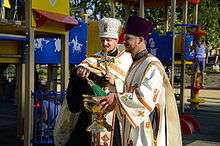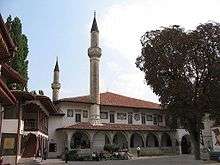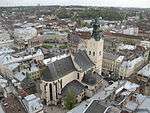Religion in Ukraine
Religion in Ukraine (2006)[1]
Ukraine in religious geography lies on the boundaries separating Roman Catholic, Eastern Orthodox and Islamic spheres of influence. Traces of the cultural influence of Catholic Lithuania and Poland, of Kievan and Muscovite Orthodoxy, and of Tatar and Ottoman Islam combine with the Soviet legacy of promoting atheism to shape the various present-day beliefs and professed beliefs of Ukrainian citizens.
History
In pre-historic times and in the early Middle Ages, the territories of present-day Ukraine supported different tribes practicing their traditional pagan religions (though note for example Tengrism of Old Great Bulgaria in the Ukrainian lands in the 7th century CE). Byzantine-rite Christianity first became prominent about the turn of the first millennium. (Later writers who sought to put Kievan Christianity on the same level of primacy as Byzantine Christianity imagined that the Apostle Andrew himself had visited the site where the city of Kiev would later arise.)
In the 10th century the emerging state of Kievan Rus' came increasingly under the cultural influence of the Byzantine Empire. The first recorded Rus' convert to Eastern Orthodoxy, the Princess Saint Olga, visited Constantinople in 945 or 957. In the 980s, according to tradition, Olga's grandson, Knyaz (Prince) Vladimir baptised his people in the Dnieper River. This began a long history of the dominance of the Eastern Orthodoxy in Ruthenia, a religious ascendancy that would later influence both Ukraine and Russia. Domination of Little Russia by Moscow eventually led to the decline of Uniate Catholicism in Tsarist-controlled Ukraine.
Judaism has existed in the Ukrainian lands for approximately 2000 years: Jewish traders appeared in Greek colonies. After the 7th century Judaism influenced the neighbouring Khazar Khaganate. From the 13th century Ashkenazi Jewish presence in Ukraine increased significantly. In the 18th century a new teaching of Judaism originated and became established in the Ukrainian lands - Hasidism.
The Golden Horde (which adopted Islam in 1313) and the Sunni Ottoman Empire (which conquered the Ukrainian litoral in the 1470s) brought Islam to their subject territories in present-day Ukraine. Crimean Tatars accepted Islam as the state religion (1313-1502) of the Golden Horde and later as vassals of the Ottoman Empire (until the late 18th-century).
During the period of Soviet rule (1917-1991) the governing Soviet authorities officially promoted atheism and taught it in schools, while promoting various levels of persecution of religious believers and of their organizations. Only a small fraction of people remained official church-goers in that period, and the number of non-believers increased.
Religious structure of society
General outlook
Estimates compiled by the independent Razumkov Centre in a nationwide survey in 2003 found that 75.2 percent of the respondents believe in God and 22 percent said they did not believe in God. 37.4 percent said that they attended church on regular basis.
According to 2010 Pew Research Center study, about 83.8% of the total Ukrainian population are Christians or 38 million.[8] And about 76.7% of the total Ukrainian population are Eastern Orthodox chrisitans or 34.8 million.[9]
As of January 1, 2006, there were 30,507 registered religious organizations, including 29,262 religious communities; the Government estimated that there were approximately 1,679 unregistered religious communities. More than 90 percent of religiously active citizens were Christians, the majority Orthodox. Religious practice was generally stronger in the western part of the country due to Western Ukraine being part of Soviet Union for shorter period(1939–41; 1944–91).
The different confessions in Ukrainian society were estimated by the nationwide survey. The result differ from the official number of registered religious groups. Thus the Russian Orthodox church (today in Ukraine, it is called the Ukrainian Orthodox Church (Moscow Patriarchate)) traditionally (since the times of the Russian Empire and the Soviet Union) has enjoyed the favour of many local authorities.
The 2006 Razumkov Centre survey indicates:[10]
- 14.9 percent of believers identify themselves with the Ukrainian Orthodox Church - Kiev Patriarchate;
- 10.9 percent are adherents of Ukrainian Orthodox Church (Moscow Patriarchate) (which has the largest number of churches in Ukraine and claims up to 75% of the Ukrainian population[11]);
- 5.3 percent belonged to the Ukrainian Greek Catholic Church (sometimes referred to as the Uniate, Byzantine, or Eastern Rite Church);
- 1.0 percent belonged to the Ukrainian Autocephalous Orthodox Church;
- 0.6 percent belonged to the Roman Catholic Church;
- 0.9 percent identified themselves as Protestants (Pentecostal, Baptist, Lutheran, Mennonites, Adventists);
- 0.1 percent follow Jewish religious practices;
- 3.2 percent said they belonged to "other denominations".
- 62.5 percent stated they are not religious or did not clearly identified their church allegiance (many Orthodox Ukrainians do not clearly self-identify with a particular denomination and, sometimes, are even unaware of the affiliation of the church they attend as well as of the controversy itself, which indicates the impossibility to use the survey numbers as an indicator of a relative strength of the church).
- General scope
- Christians - 33.6%
- Eastern Orthodox - 26.8%
- Catholic - 5.9%
- Protestants - 0.9%
- Jewish - 0.1%
- other - 3.8%
- no affiliation/not aware - 62.5%
- Religious community
- Christians - 89.6%
- Eastern Orthodox (Kiev-55.3%, Moscow-40.8%, Autocephalous-3.9%) - 72.0%
- Catholics (Greek-89.2%, Roman-10.8%) - 15.8%
- Protestants - 2.4%
- Islam - 0.6%
- Jewish - 0.2%
- others - 9%
All-Ukrainian Council of Churches and Religious Organizations
Since December 1996 in Ukraine exists All-Ukrainian Council of Churches and Religious Organizations that unites around 90-95% of religious communities of Ukraine.[12][13] Since the end of 2003 parallel to the council exists Conference of leaders of Christian Churches of Ukraine.[14] Affiliation in both assemblies is without any obligations.
In 2007 the council was accounted for representatives of 19 organizations, in 2013 - only 18. The Conference of leaders was accounted for representatives of 9 churches.
Eastern Orthodoxy
Ukrainian Orthodox Church (Moscow Patriarchate)

The Ukrainian Orthodox Church (Moscow Patriarchate) (UOC) has 35 eparchies and 10,875 communities (approximately 68 percent of all Orthodox Christian communities in the country), most of which were located in the central, southern, and eastern oblasts. By 2007, the Church had 122 monasteries, 3519 monks and nuns, 7509 priests, 7755 churches with 840 churches being built.[15]
The Church is headed by the Metropolitan of Kiev and all Ukraine, Onuphrius (Berezovsky). This Church uses predominately the Old Slavonic language for services.
Ukrainian Orthodox Church - Kiev Patriarchate
The Ukrainian Orthodox Church - Kiev Patriarchate (UOC-KP) was formed after independence and has been headed since 1995 by Patriarch Filaret (Denysenko) with the title Patriarch of Kiev and all Rus-Ukraine, who was earlier the Russian Orthodox Metropolitan of Kiev and all Ukraine. The Church claims direct lineage to the Kievan Metropolia of Petro Mohyla.
The UOC-KP had 31 eparchies, 3,721 communities, and 2,816 clergy members. Approximately 60 percent of the UOC-KP faithful live in the western part of the country. The UOC-KP was not recognized by the Eastern Orthodox Communion.
The UOC-KP uses Ukrainian and Slavonic as liturgical languages.
Ukrainian Autocephalous Orthodox Church
The Ukrainian Autocephalous Orthodox Church (UAOC) was founded in 1919 in Kiev. Banned during the Soviet era, it was legalized in 1989.
The church has 12 eparchies and 1,166 communities, approximately 70 percent of them in the western part of the country. The UAOC has 686 clergy members.
In the interest of the possible future unification of the country's Orthodox churches, it did not name a patriarch to succeed the late Patriarch Dmitriy. The UAOC was formally headed in the country by Metropolitan Methodij of Ternopil and Podil; however, the large eparchies of Kharkiv-Poltava, Lviv, Rivne-Volyn, and Tavriya have officially broken relations with Methodij and have asked to be placed under the direct jurisdiction of the Istanbul-based Ecumenical Patriarch Bartholomew.
The UAOC uses the Ukrainian language.
Other Orthodox Churches
There are also Russian Orthodox Old-Rite Church, Russian Orthodox Church Abroad, Ruthenian True Orthodox Church, Romanian Orthodox Church (Metropolis of Bessarabia), Ukrainian Autocephalous Orthodox Church Canonical, Autonomous Ukrainian Orthodox Church in America, Ukrainian True Orthodox Church, Ukrainian Reformation Orthodox Church, Orthodox Russian Church, Ukrainian Autocephalous Orthodox Church - Apostolic (catacombic), and some very marginal (Ukrainian Autocephalous Orthodox Church - Apostolic, Autonomous Orthodox Church of Lviv, True Orthodox Church of Greece, Catacombic True Orthodox Church) and the Armenian Apostolic Orthodox Church (Oriental Orthodox miaphysites).
Catholics
Ukrainian Greek Catholic Church

The Ukrainian Greek Catholic Church (UGCC) constituted the second largest group of believers after the Christian Orthodox churches. The Union of Brest formed the Church in 1596 to unify Orthodox and Roman Catholic believers. Outlawed by the Soviet Union in 1946 and legalized in 1987, the UGCC was for forty-three years the single largest banned religious community in the world.
The UGCC had 18 eparchies, 3,433 communities, and 2,136 clergy members. The UGCC's members, who constituted a majority of the believers in western Ukraine, numbered approximately four million.
Major Archbishop Sviatoslav Shevchuk is the present head of the Ukrainian Greek Catholic Church.[16]
The UGCC uses the Ukrainian language.
Roman Catholic Church
The Roman Catholic Church is traditionally associated with historical pockets of citizens of Polish ancestry who lived mainly in the central and western regions.
The Roman Catholic Church had 7 dioceses, 879 communities, and 499 clergy members serving approximately one million persons.
The Church uses the Polish, Latin, Ukrainian and Russian languages.
Ruthenian Catholic Church
Other Catholics
The Armenian Catholic Church has a small presence.[17]
Ukrainian Protestant Churches
Protestants make from 1% to nearly 3% of the population in Ukraine, but they constitute over 25% of the church network in the country. The biggest is the Christians of Pentecostal confession with over 2,500 churches and over 250,000 members that make several unions and also there are 1,560 Charismatic churches. There are over 2,500 Evangelical Christian Baptists unions with over 150,000 members, plus Methodists, Mennonites, Lutherans, Presbyterians, and others. There is also a Sub-Carpathian Reformed Church with about 140,000 members, which is one of the earliest Protestant communities in the country.
Other Christian churches and movements
The Embassy of God of Sunday Adelaja maintains a significant presence throughout the country, as do other neopentecostal groups. Jehovah’s Witnesses are strong, with 265,985 adherents reported in the movement’s 2013 Yearbook. In 2010 the Church of Jesus Christ of Latter-day Saints (Mormons) dedicated its Kyiv Ukraine Temple, and in 2012 claimed a membership more than 11,000 in 57 congregations in Ukraine.[18] Other active movements include Seventh-day Adventists, The Local Churches of Witness Lee, United Pentecostal Church (Oneness), and Branhamites.
Islam

According to a 2009 Pew Research Center report, there are an estimated 456,000 Muslims in Ukraine.[19] In the Crimea, the Ukrainian Muslims make up to 12% of the population. A major part of the south steppes of modern Ukraine at a certain period of time belonged to the Turkic peoples, most of whom were Muslims since the fall of the Khazar Khanate.
The Crimean Tatars are the only indigenous Muslim ethnic group in the country. The Nogays, another Muslim group who lived in the steppes of southern Ukraine, emigrated to Turkey in the 18th-19th century. In addition, there are Muslim communities in all major Ukrainian cities representing Soviet-era migrants from Muslim backgrounds. There are approximately 150 mosques in Ukraine. Many Muslim mosques use the Crimean Tatarian, Arabic, Azeri, Tatarian and Russian languages.
There are no single administrative center, instead there are five of them: Spiritual Administration of Crimea Muslims (DUMK) - Crimean Tatars; Spiritual Administration of Ukraine Muslims (DUMU) - people of Caucasus, Crimean and Volga Tatars, Pakistani, Afghans, Arabs, Russians, Ukrainians; Spiritual Center of Ukraine Muslims (DCUM) - Volga Tatars; Kiev muftiat - Kazan and Volga Tatars; UMMA - Arabs, Uzbeks, Russians, Ukrainians.[20]
Judaism
The size of the current Jewish population varied. The State Committee of Statistics estimated that there were 103,600 Jews. Some Jewish leaders, said the Jewish population could be as high as 300 thousand. Observers believed that 35 to 40 percent of the Jewish population was active communally; there were 240 registered Jewish organizations. Most observant Jews were Orthodox. There were 104 Chabad-Lubavitch communities in the country. The Progressive (Reform) Jewish movement had forty-eight communities. There are four major branches: Orthodox, Conservators, Progressive reformers, Reconstructionists.[21]
Judaic congregations use Russian, Hebrew, Yiddish and Ukrainian.
Hinduism
Hinduism is a minority faith in Ukraine.The International Society for Krishna Consciousness managed to propagate the Hindu faith through their missionary activities.
Paganism
.png)
Ridnoviry
The largest group (federation) of Slavic native faith (Ridnoviry) is the Obiednannia Ridnoviriv Ukrayiny (Об`єднання Рідновірів України "Native Faith Association of Ukraine"), founded in 1998 by Halyna Lozko. The federation has chapters in Kiev, Kharkiv, Odessa, Boryspil, Chernihiv, Mykolaiv, Lviv and Yuzhnoukrainsk.
Lev Sylenko founded the RUNVira (Church of the Ukrainian National Faith) in 1966 in Chicago, United States, and only opened their first temple in the mother country of Ukraine after the breakup of the Soviet Union in 1991. The current headquarters of RUNVira is in Spring Glen, New York, USA. "Sylenkoism" and RUNVira espouse a monist theology centered around the god Dazhbog, where RUNVira derives its denomination of "Dazhbogite".
Scholars estimated 95.000 Rodnovers (0.2%) in Ukraine in the 2000s.[22]
Cultus Deorum Romanorum
The group of worshipers of gods according to the Roman way Sarmatia (Roman name for modern-day Ukraine) is building a Temple of Jupiter Perennus or Jupiter Perunnus (Perun) in the city of Poltava. The site was attacked and desacrated by Christians in 2011, but construction works continue to the present.[23]
Gallery
- Cathedral of the Assumption, Kyiv (1078, rebuilt in 2000)
- St. Micahels Golden-Domed Cathedral, Kyiv (1113, rebuilt in 1999)
 Church of Our Lady Pyrohoshcha, Kyiv (1132, rebuilt in 1997-1998)
Church of Our Lady Pyrohoshcha, Kyiv (1132, rebuilt in 1997-1998) Church of St. Nicholas, Kyiv (1899-1909)
Church of St. Nicholas, Kyiv (1899-1909) Trinity Cathedral, Chernihiv (1695)
Trinity Cathedral, Chernihiv (1695)- Trinity Cathedral, Sumy (1913)
 Latin Cathedral, Lviv (approx. 1493)
Latin Cathedral, Lviv (approx. 1493)- St. George's Cathedral, Lviv (1760)
 Church of St. Elizabeth, Lviv (1903-1911)
Church of St. Elizabeth, Lviv (1903-1911)- Church of the Nativity, Ternopil (1602-1608)
 Holy Resurrection Cathedral, Ivano-Frankivsk (1729-1763)
Holy Resurrection Cathedral, Ivano-Frankivsk (1729-1763) Transfiguration Cathedral, Vinnytsia (1758)
Transfiguration Cathedral, Vinnytsia (1758) Church of St. Martin, Mukachevo (1904)
Church of St. Martin, Mukachevo (1904) Church of the Nativity of the Blessed Virgin, Stryi (1425, rebuilt in 1891).
Church of the Nativity of the Blessed Virgin, Stryi (1425, rebuilt in 1891).- Saint Bartholomew church, Drohobych (XV century, rebuilt in 1906-1913)
 Church of St. Stanislaus, Chortkiv (1619, rebuilt in the early XX century)
Church of St. Stanislaus, Chortkiv (1619, rebuilt in the early XX century)- Church of St. Anna, Bar (1811)
- Church of the Assumption of the Heart of Jesus, Chernivtsi (1892-1894)
 Neo-Gothic church of St. Anne, Ozeriany (1875)
Neo-Gothic church of St. Anne, Ozeriany (1875).jpg) Central Lutheran Cathedral Ukraine St. Paul, Odesa (1827)
Central Lutheran Cathedral Ukraine St. Paul, Odesa (1827) Church of St. Nicholas, Dnipropetrovsk (1895)
Church of St. Nicholas, Dnipropetrovsk (1895) Church of the Assumption of the Blessed Virgin Mary, Otynia (1905-1918)
Church of the Assumption of the Blessed Virgin Mary, Otynia (1905-1918)
See also
- History of Christianity in Ukraine
- Hinduism in Ukraine
- Islam in Ukraine
- History of the Jews in Ukraine
- Religion by country
- Roman Catholicism in Ukraine
- Protestantism in Ukraine
- Ukrainian Bible Society
- Bahá'í Faith in Ukraine
References
- ↑ "What religious group do you belong to?". Sociology poll by Razumkov Centre about the religious situation in Ukraine (2006)
- ↑ "Kiev Saint Sophia Cathedral". United Nations Educational, Scientific and Cultural Organisation (UNESCO). UN. Retrieved 2008-07-08.
- ↑ "What religious group do you belong to?". Sociology poll by Razumkov Centre about the religious situation in Ukraine (2006)
- ↑ "RISU /English /News /Ukrainians Trust Church, Army, Media Most:". Old.risu.org.ua. Retrieved October 31, 2011.
- ↑ Eke, Steven (July 27, 2009). "Russian patriarch visits Ukraine". BBC News. Retrieved October 31, 2011.
- ↑ "CIA the World Fact Book". Cia.gov. Retrieved December 30, 2010.
- ↑ "Countries in Crisis: Ukraine Part 3". Stratfor.com. November 20, 2008. Retrieved December 30, 2010.
- ↑ Global Christianity – A Report on the Size and Distribution of the World’s Christian Population p.47
- ↑ Global Christianity – A Report on the Size and Distribution of the World’s Christian Population
- ↑ "What religious group do you belong to?" Sociology poll by Razumkov Centre about the religious situation in Ukraine (2006)
- ↑ Pravoslvieye v Ukraine Retrieved on 10 February 2007
- ↑ All-Ukrainian Council of Churches and Religious Organizations. RISU. December 10, 2009
- ↑ . All-Ukrainian Council website. April 24, 2013
- ↑ Conference of leaders of Christian Churches of Ukraine. RISU. December 10, 2009
- ↑ Religious Information Service of Ukraine
- ↑ Religious Information Service of Ukraine
- ↑ Religious Information Service of Ukraine
- ↑ LDS Newsroom (Statistical Information)
- ↑ http://pewforum.org/uploadedfiles/Topics/Demographics/Muslimpopulation.pdf
- ↑ Islam. RISU. January 29, 2010
- ↑ Differences among Judaism branches. RISU. December 13, 2009
- ↑ Adrian Ivakhiv. In Search of Deeper Identities. Neopaganism and “Native Faith” in Contemporary Ukraine. Nova Religio 8, no. 3 (March 2005). p. 17.
- ↑ http://wildhunt.org/2011/10/ukrainian-pagan-temple-attacked-and-other-pagan-news-of-note.html



